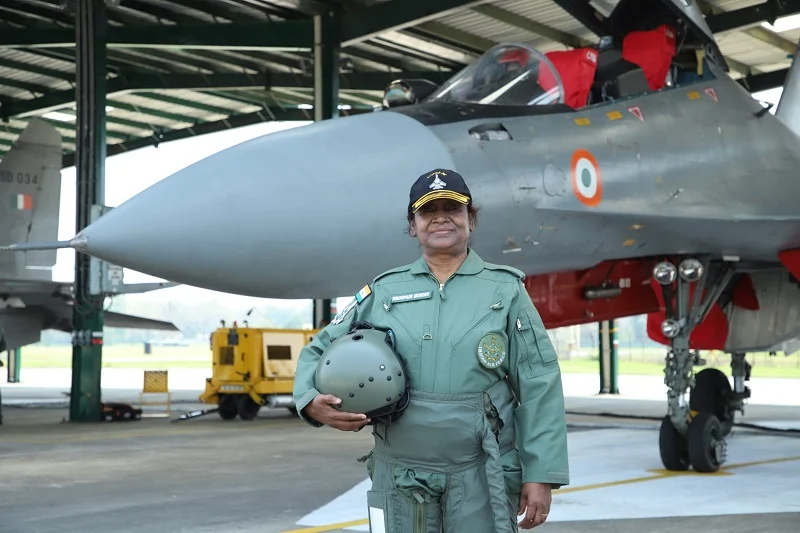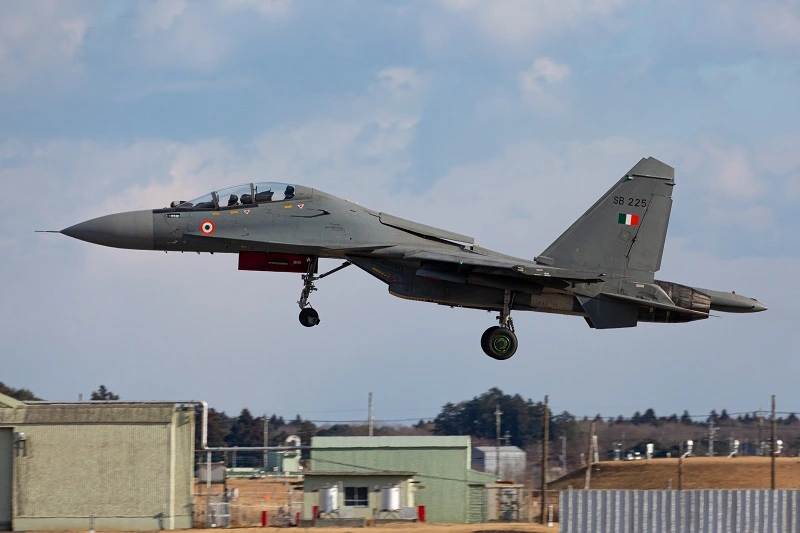

President Droupadi Murmu took a historic sortie in a Sukhoi 30 MKI fighter aircraft this April at the Tezpur Air Force Station in Assam (File image courtesy: Rashtrapati Bhavan)
The Defence Acquisition Council (DAC) clearing procurement of 12 Sukhoi Su-30 MKI Aircraft with associated equipment from Hindustan Aeronautics Limited (HAL) is expected to address the long-felt need of the Indian Air Force (IAF) to increase its fighter squadrons.
The DAC headed by Defence Minister Rajnath Singh accorded its Acceptance of Necessity (AoN) for nine capital acquisition proposals valued at approximately Rs 45,000 crore.
The move would provide a substantial boost to the country’s defence industry and reduce foreign spending significantly as
all these procurements will be made from Indian vendors under the ‘Buy (Indian)’, ‘Buy & Make (Indian)’ and ‘Buy Indian IDDM’ (Indigenously Designed, Developed and Manufactured) categories.
It is expected that such quantum of indigenous procurement will galvanise the Indian industries towards achieving the goal of ‘Aatmanirbhar Bharat’.
India remains one of the major foreign operators of Russia’s Su-30 type fighters with the programme for licensed production of Su-30MKIs forming the backbone of the country’s air force.


In comparison to Russian SU-30, indigenously manufacturing the SU-30 MKI aircraft has been a costly affair owing to the additional modifications incorporated to enhance the operational capability and suit IAF requirements.
Being a Transfer of Technology (ToT) programme, there is also cost involved towards payment of license fee to Russian side besides dependency on Russian Original Equipment Manufacturers (OEMs) for import of raw materials and proprietary components.
The Russian state-owned arms exporter Rosoboronexport has also been showing a keen interest to supply additional technical kits for assembling the Su-30MKI and carry out joint work on their modernization, including the integration of the latest aircraft weapons, avionics, etc.
However, indigenous manufacturing has now created advanced skill sets in the country, a step towards self-reliance and will result in lower Life Cycle Cost and reduced dependency on OEMs on repair and maintenance, a faster turn-around time and quick support to the IAF bases.
Since the facilities are indigenously established, future production supplies are likely to be cheaper when new order for bulk production are placed on HAL.
On Friday, the DAC gave its go-ahead for procurement of Light Armoured Multipurpose Vehicles (LAMV), Integrated Surveillance and Targeting System (ISAT-S) and High Mobility Vehicle (HMV) Gun Towing Vehicles that will enhance protection, mobility, attack capability and increased survivability of Indian forces.
It also approved procurement of Next Generation Survey Vessels for the Indian Navy which will greatly boost its capabilities in performing Hydrographic Operations.
Other proposals that were cleared included included avionic upgradation of Dornier aircraft to improve the accuracy and reliability for operations and procurement of Dhruvastra Short Range Air-to-Surface Missile as a potent Indigenous Precision Guided Weapon for indigenously built ALH Mk-IV Helicopters.
“Rather than a threshold of 50% indigenous content for IDDM projects, we should aim for a minimum 60-65% indigenous content,” said Defence Minister Singh while urging to work towards increasing the minimum indigenous content threshold in consultation with the Indian industry.
A few weeks ago, the DAC gave its nod to capital acquisition proposals worth approximately Rs 7800 crore that included procurement and installation of Electronic Warfare (EW) Suite on Mi-17 V5 Helicopter fleet of the IAF.
To be procured from Bharat Electronics Limited (BEL) under Buy Indian-IDDM (Indigenously Designed, Developed and Manufactured) category, the advanced EW systems will significantly enhance the battle-survivability of the multi-purpose helicopters while undertaking operational missions against adversaries’ ground-based as well as airborne fire control and surveillance radars.
The development follows last year’s contract between the BEL and Defence Ministry for supply of Advanced Electronic Warfare Suite for IAF fighter aircraft estimated to be around Rs 1993 crore.
Also Read: India to acquire 26 Rafale naval jets from France for carrier operations on INS Vikrant
Australia's High Commissioner to India, Philip Green OAM, called Yoga one of India's gifts to…
The Bharat Sanchar Nigam Limited (BSNL) has announced the soft launch of BSNL Quantum 5G…
The Indian Embassy in Iran has said that the embassy will make efforts to evacuate…
India's gross direct tax collections for the financial year 2025-26 rose by 4.86 per cent…
Russian President Vladimir Putin has said that Moscow is not seeking Ukraine's unconditional surrender, but…
Extending his greetings on the 11th International Day of Yoga, Lok Sabha speaker Om Birla…